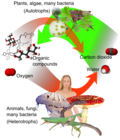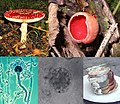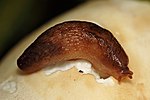 | A heterotroph (/ˈhɛtərəˌtroʊf, -ˌtrɒf/; from Ancient Greek ἕτερος (héteros) 'other', and τροφή (trophḗ) 'nutrition') is an organism that cannot produce... 27 KB (2,935 words) - 20:11, 6 April 2024 |
 | Myco-heterotrophy (redirect from Myco-heterotrophs) food from parasitism upon fungi rather than from photosynthesis. A myco-heterotroph is the parasitic plant partner in this relationship. Myco-heterotrophy... 16 KB (1,531 words) - 19:18, 8 November 2023 |
 | Phototroph (redirect from Phototrophic heterotroph) energy currency for the cell. Phototrophs can be either autotrophs or heterotrophs. If their electron and hydrogen donors are inorganic compounds (e.g.... 8 KB (737 words) - 01:11, 6 August 2023 |
 | Carbon source (biology) (section Heterotrophs) organism to synthesise biomass. Such sources may be organic or inorganic. Heterotrophs must use organic molecules as a source of both carbon and energy. In... 2 KB (498 words) - 09:12, 5 January 2024 |
Chemotroph (redirect from Chemotrophic heterotroph) as a synonym of chemoautotrophy. Chemoheterotrophs (or chemotrophic heterotrophs) are unable to fix carbon to form their own organic compounds. Chemoheterotrophs... 8 KB (816 words) - 03:47, 27 April 2024 |
creature that eats organisms from a different population. A consumer is a heterotroph and a producer is an autotroph. Like sea angels, they take in organic... 5 KB (597 words) - 23:24, 7 April 2024 |
which are vital for other species within the ecosystem. Ecology portal Heterotroph Lithotroph Ecological pyramid Predator-prey interaction "The Food Chain"... 17 KB (1,932 words) - 11:04, 27 April 2024 |
that transfer energy in the anabolic processes of ATP synthesis (in heterotrophs) or biosynthesis (in autotrophs). The electron or hydrogen donors are... 19 KB (1,616 words) - 12:21, 22 January 2024 |
 | some protists is chitin in their cell walls. Fungi, like animals, are heterotrophs; they acquire their food by absorbing dissolved molecules, typically... 200 KB (19,084 words) - 20:30, 1 April 2024 |
This mode of nutrition is also known as heterotrophic nutrition. All heterotrophs (except blood and gut parasites) have to convert solid food into soluble... 3 KB (216 words) - 02:09, 20 October 2023 |
dioxide through anaplerotic fixation. The flavobacterium is still a heterotroph as it needs reduced carbon compounds to live and cannot subsist on only... 20 KB (2,138 words) - 18:04, 3 December 2023 |
 | that the common ancestor of all living eukaryotes was a flagellated heterotroph. Amoebae, which usually lack flagella but move through changes in the... 94 KB (9,774 words) - 12:29, 17 April 2024 |
 | Ecologists can broadly define all life forms as either autotrophs or heterotrophs, based on their trophic levels, the position that they occupy in the... 83 KB (8,618 words) - 00:25, 11 March 2024 |
 | Monotropastrum humile, a myco-heterotroph dependent on fungi throughout its lifetime... 31 KB (3,724 words) - 03:00, 17 March 2024 |















